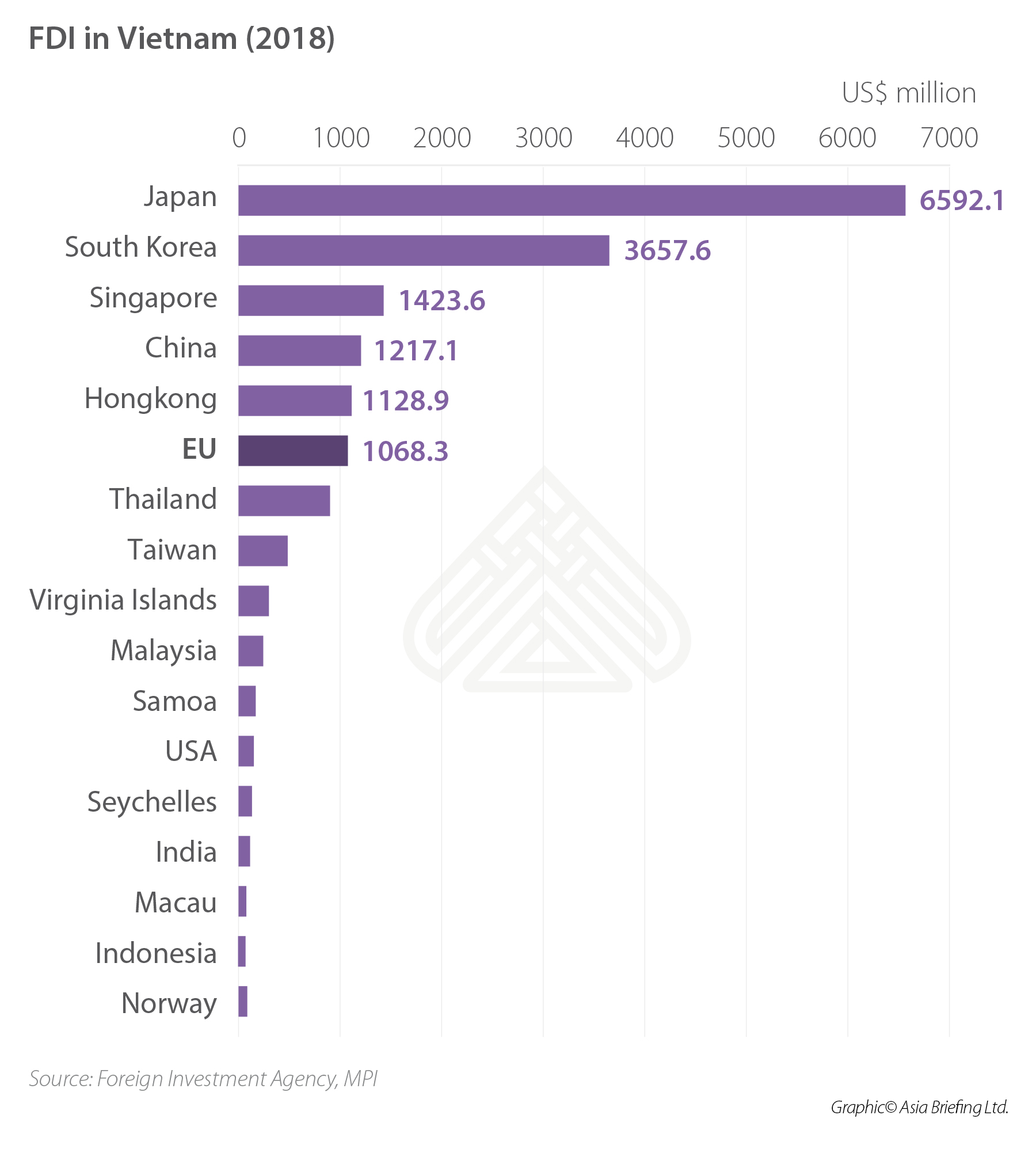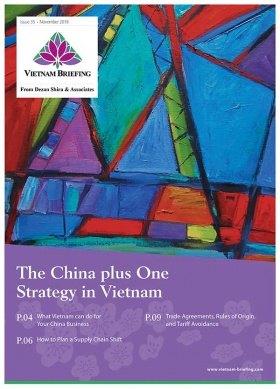Vietnam-EU Trade: EVFTA Comes Into Effect
- The EVFTA took effect on August 1 paving the way for increased trade between the EU and Vietnam.
- Analysts hope the trade deal will give a much-needed boost to Vietnam’s economy as it looks to recover from the COVID-19 pandemic.
- The EVFTA is an ambitious pact eliminating almost 99 percent of customs duties between the EU and Vietnam.
The European Union Vietnam Free Trade Agreement (EVFTA) took effect on August 1 paving the way for increased trade between the EU and Vietnam.
The EVFTA is an ambitious pact providing almost 99 percent of the elimination of custom duties between the EU and Vietnam. As per the Ministry of Planning and Investment (MPI), the FTA is expected to help increase Vietnam’s GDP by 4.6 percent and its exports to the EU by 42.7 percent by 2025. While the European Commission has forecast the EU’s GDP to increase by US$29.5 billion by 2035.
Vietnam’s National Assembly on June 8 ratified the EVFTA and the EU-Vietnam Investment Protection Agreement (EVIPA) following almost 10 years of negotiations.
Analysts hope the trade deal will give a much-needed boost to Vietnam’s industries, such as manufacturing, as it looks to recover from the COVID-19 pandemic.
About 65 percent of duties on EU exports to Vietnam will be eliminated while the remaining will be gradually phased out over a period of 10 years. 71 percent of duties will be eliminated on Vietnam exports to the EU, with the remaining being eliminated over a period of seven years.
The EVFTA is considered a new generation bilateral agreement – it contains important provisions for intellectual property (IP) rights, investment liberalization, and sustainable development. This includes a commitment to implement the International Labor Organization (ILO) standards and the UN Convention on Climate Change.
Talks between the EU and Vietnam began in October 2010 with negations concluding in December 2015, however, the ratification process was delayed due to specific details on tariffs as well as the EU-Singapore FTA, which came in November 2019.
Vietnam and the EU are long-standing trading partners. At the end of 2018, EU investors had invested more than US$23.9 billion in 2,133 projects in Vietnam. In 2018, European investors added almost US$1.1 billion in Vietnam.
EU investors are active in 18 economic sectors and in 52 out of the 63 provinces in Vietnam. Investment has been the most prominent in manufacturing, electricity and real estate.
The bulk of the EU investment has been concentrated in areas with good infrastructure, such as Hanoi, Quang Ninh, Ho Chi Minh City, Ba Ria-Vung Tau, and Dong Nai. 24 EU member states are invested in Vietnam, with the Netherlands taking the top spot followed by France and the UK.
At the regional level, Vietnam is now the EU’s second most important trading partner among all ASEAN members – surpassing regional rivals Indonesia and Thailand, in recent years. The growing trade between the EU and Vietnam also helps to solidify ASEAN’s position as the EU’s third-largest trading partner.
See also: Vietnam’s Free Trade Agreements – Opportunities for Your Business
Industries primed for continued expansion
The EVFTA, at its core, aims to liberalize both tariff and non-tariff barriers for key imports on both sides over a period of 10 years.
For Vietnam, the tariff elimination will benefit key export industries, including the manufacturing of smartphones and electronic products, textiles, footwear and agricultural products, such as coffee. These industries are also very labor-intensive. Increasing Vietnam’s export volume to the EU, the FTA will facilitate the expansion of these industries, both in terms of capital and increasing employment.
Textiles
Both Vietnam and the EU have articulated a timeframe by which they have committed to liberalizing all tariffs. Key among these commitments is a seven-year timeline for Vietnam’s textile and footwear products. Exports of the sector reached around US$9 billion in 2018. As a large proportion of Vietnam’s exports to the EU are consumer goods such as clothing, textile, and footwear, the FTA could significantly increase their trade volume.
Electronics
As Vietnam continues to grow, it will shift its manufacturing sector towards more technologically advanced products, such as smartphones and other electronics. The EVFTA will provide more export revenue from clothing and footwear products, but may not impact the expansion of these industries.
Although Vietnam is yet to have an extensive developed electronic manufacturing industry at present, the FTA provides Vietnam with an unprecedented chance to take a lead in electronic products, and hence expansion of this budding industry could be a smart move for local businesses.
Pharmaceuticals
Vietnam’s pharmaceutical market remains attractive to EU investors. With the FTA in effect, approximately half of EU pharmaceutical imports will be duty-free immediately with the rest exempted from duty after seven years. Foreign pharmaceutical companies will be allowed to establish a company to import pharmaceuticals that have been authorized to be sold in the Vietnamese market. Such entities can sell pharmaceuticals imported by them to Vietnamese distributors or wholesalers. The entities can also build their own warehouses.
While Vietnam’s pharmaceutical market has significantly developed, it still only meets 52 percent of market demand contributed mostly by generic drugs. The new FTA will bring fair and equal access to the market enabling EU investors to further expand their business and thus allowing foreign investors to meet the strong growth of the pharmaceutical sector
Key highlights of the EVFTA
Remanufactured goods
Previously, remanufactured goods were considered ‘used’ by Vietnam and typically not allowed for import. However, the text of the agreement allows remanufactured goods to be imported and will open up trade for high-value products such as medical devices and car parts to serve the after-sales market. Vietnam can still continue to restrict specific used goods under the most favored nation (MFN) conditions.
Repaired goods
The temporary import and export of repaired goods will be duty-free. This will ensure fair and competition conditions particularly for specialized maintenance services such as aircraft.
Made in EU
Vietnam will accept ‘Made in EU’ products for non-agricultural items for the first time reflecting the integration of the EU market. With the exception of pharmaceuticals which are subject to national approvals, this will allow manufacturers to use the EU’s broader internal market.
Fees and formalities
Consular transactions are no longer needed under the FTA while consular authentication will not be required three years the FTA is in effect.
Upcoming challenges
Recent changes in the EU, in particular Brexit, could impact the outcome and importance of the EVFTA. For now, the FTA will take effect for the UK until the end of the year and could be extended for another 24 months as per the UK’s agreement with the EU.
Nevertheless, considering that the UK is one of the biggest markets for Vietnam’s exports, and also one of Vietnam’s biggest investors, trade and investment from the UK is likely to remain in limbo as long the markets are processing the post Brexit fallout. However, Vietnam sees opportunities if Brexit comes into play.
The impact of Brexit on EU trade and investment is, however, another story. While the turmoil of Brexit amplifies an existential crisis that has been manifesting in Europe for some time, there are strong reasons to believe that Vietnam will continue to reap the benefits of European trade in the years to come.
Much of this boils down to the EU’s increasingly stringent standards and quality controls applied to goods coming into the EU. Unlike many of its ASEAN neighbors, Vietnam has been successful in concluding a trade agreement with the EU.
Included within this agreement are numerous provisions that help to converge Vietnamese standards with those of the EU. The importance of the Vietnamese market will only grow as elements of the EVFTA are implemented and corresponding non-tariff barriers are removed.
Note: This article was first published in July 2016, and has been updated to include the latest developments.
EVFTA FAQs
What is the EVFTA?The EVFTA is a free trade agreement between the European Union and Vietnam. It came into effect on August 1 2020.
About Us
Vietnam Briefing is produced by Dezan Shira & Associates. The firm assists foreign investors throughout Asia from offices across the world, including in Hanoi and Ho Chi Minh City. Readers may write to vietnam@dezshira.com for more support on doing business in Vietnam.
- Previous Article Vietnam’s Lao Cai: An Investment Spotlight
- Next Article Assessing Vietnam’s Economic Prospects for Foreign Investors After COVID-19 – Latest Issue of Vietnam Briefing Magazine








